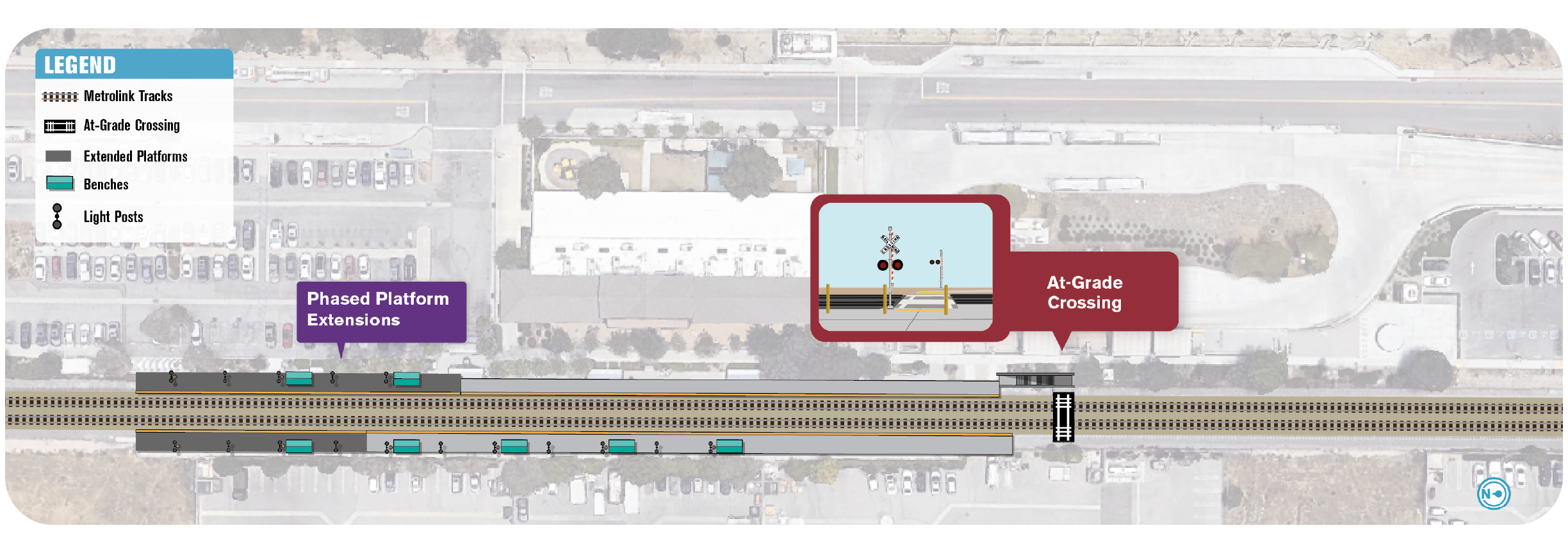
CHATSWORTH STATION IMPROVEMENTS PROJECT:
VENTURA COUNTY LINE
As part of the Southern California Optimized Rail Expansion (SCORE) Program, the Southern California Regional Rail Authority (Metrolink) is advancing the Chatsworth Station and Signal Improvements (Project) to improve passenger safety and enable more frequent and reliable services.
The Project includes a short extension of the platform, as well as a new pedestrian crossing at Chatsworth Station. In the project area, there is one at-grade crossing in the station that will be replaced with a new Metrolink standard pedestrian crossing that includes delineators, active warning devices, pedestrian gates and channelization which allows safer passenger movements between side platforms and improved operations resulting in quicker and safer transfers.
The Project would improve the rail system in several ways, including:
- Replacement of an at-grade crossing;
- A new pedestrian crossing; and
- Track improvements.
Project Map

Project Timeline

CHECK OUT THE BENEFITS:
![]() More safe, reliable service - this project, when combined with other SCORE Phase I projects, would enable more frequent service when demand and funding exist. In the future, passengers can go to a train station and wait no more than 30 minutes for the next train in either direction.
More safe, reliable service - this project, when combined with other SCORE Phase I projects, would enable more frequent service when demand and funding exist. In the future, passengers can go to a train station and wait no more than 30 minutes for the next train in either direction.
![]()
The new Metrolink standard pedestrian crossing will create pedestrian safety enhancements that will improve pedestrian access and reduce commute times.
![]()
Less idling time will reduce emissions.
Frequently Asked Questions
The proposed Chatsworth Station and Signal Improvements Project is included in Phase 1 of the Metrolink SCORE Project that will reduce commute times, enhance service, and offer better safety for passengers transferring at Chatsworth Station between Metrolink and Metro’s D Line. Improvements at Chatsworth Station include the replacement of the existing at-grade crossing within the station and a new pedestrian crossing. Passengers will benefit by not waiting more than 30 minutes for the next train in either direction. When demand and funding exist, segments of the main track at Chatsworth Station would be rehabilitated by replacing wooden ties with concrete ties to improve reliability and enhance operation services.
The new pedestrian crossing and signal improvements would generate jobs and business opportunities, improve safety for pedestrians, vehicles, and trains, provide environmental benefits, and increase the frequency and the reliability of Metrolink service. Los Angeles County would see reduced traffic congestion and emissions on adjacent freeways, as Metrolink removes the equivalent of one lane of parallel freeway traffic during the peak hour in peak direction. Lane capacity equivalent is calculated using Metrolink conductor counts and Caltrans Annual Average Data Traffic counts at peak load points within corridor. Reduced traffic congestion would also result in fewer accidents, reduced air pollution and emissions, and decreased energy consumption.
Improvements at Chatsworth Station, combined with Simi Valley Station, would increase train and passenger capacity by enabling more frequent train service at least every 30 minutes in both directions. The station improvements and track updates would allow Metrolink to provide passengers more reliable and safer services. Additionally, the underpass would reduce train idling time and allow passengers to make quicker transfers.
The Los Angeles Economic Development Corporation (LAEDC) was commissioned to produce a study assessing the impact of the construction investment of the SCORE program. The benefits from SCORE will make the region increasingly attractive for the millions projected to arrive in SoCal in 2028 and create regional prosperity in the decades to come. When demand and future funding exist, Los Angeles County residents can expect to see 45,700 new jobs and $9.801 billion in gross regional product by 2028. By 2050, there will be 704,900 new jobs and a collective total of $356 billion in economic activity.
